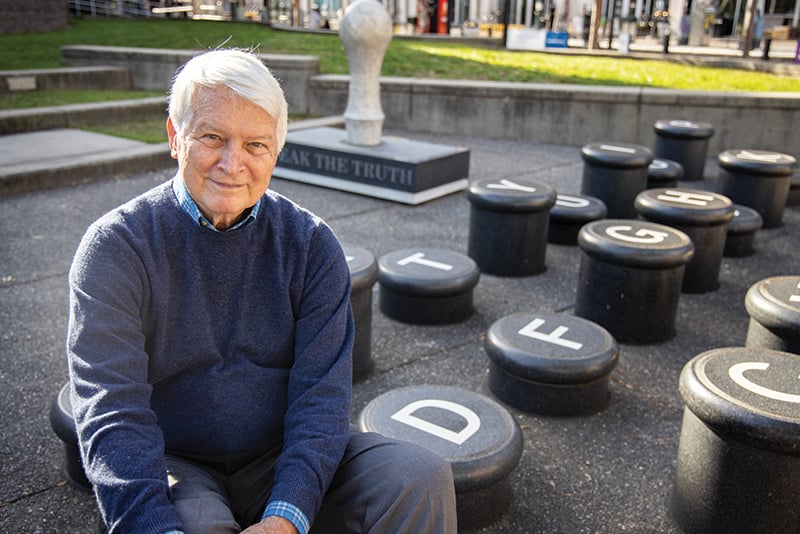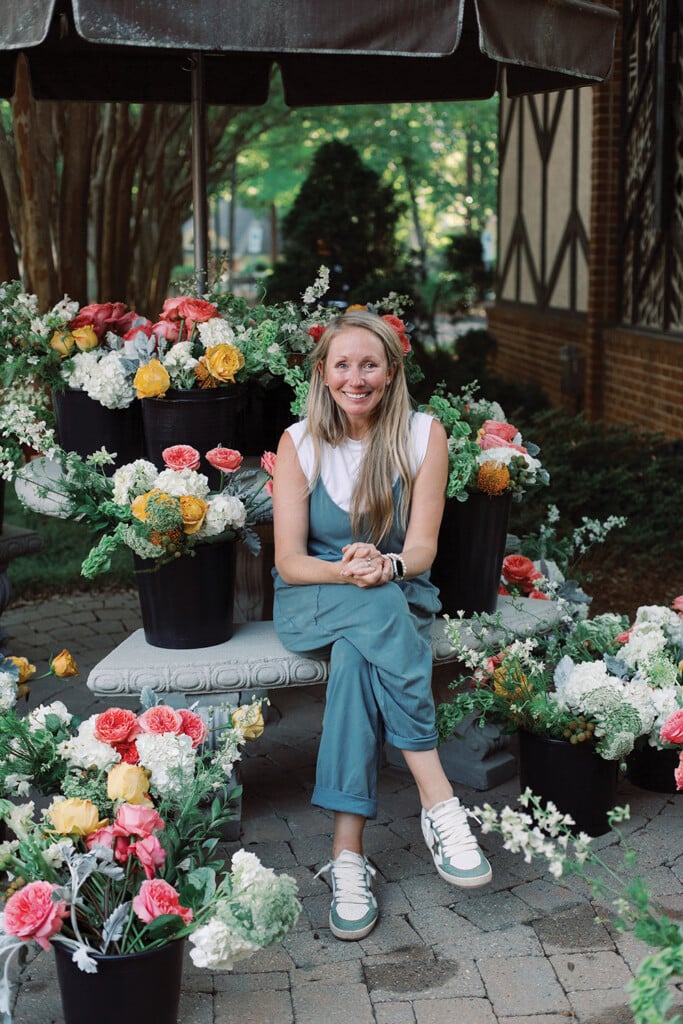2023 Charlotteans of the Year: Rolfe Neill
In memoriam: The Observer publisher envisioned a bigger, better city

Outside ImaginOn, a collection of stone sculptures represents the tools of the writer’s trade: oversized stamps emblazoned “SEEK THE TRUTH” and “SPEAK THE TRUTH,” a large granite typewriter. On a recent Monday afternoon, a child jumps from one typewriter key to another, trying to spell out her name. A woman leans against a nearby pillar and rubs lotion on her chapped feet. The plinth behind her is capped by a shining fountain pen and carved with sentences like, “Independence of mind is the best insurance for a rewarding journey.”
Those words were written by Rolfe Neill, and they originally appeared in a more ephemeral format: on newsprint in The Charlotte Observer. Neill had a Sunday column during his years as publisher from 1975 to 1997, when the paper was at its financial and journalistic peak. Even if you arrived in Charlotte after Neill retired, you live in the city he helped make—not just one that boomed economically but strived to be a small Southern utopia, even if it often fell short. Neill died on July 14, but he left behind a Charlotte where children can play in the shadows of values carved in stone, like: “On its worst days, the world is full of much more good than evil, more kindness than contempt, and more hope than resignation.”
“Charlotte was an aspirational city, and Rolfe embodied that as much as anybody,” says Jim Morrill, an Observer political reporter from 1981 to 2020. “It’s hard to overstate how important the paper was back then. We had a newsroom of 250 people, or maybe more—compared to today, it’s night and day.” On Neill’s watch, the Observer won three Pulitzer Prizes in a decade: one in 1981 for reporting on brown-lung disease, a blight on local textile workers; and two in 1988, for uncovering the scandals and fraud surrounding Jim and Tammy Faye Bakker’s PTL ministry and for cartoonist Doug Marlette.
Neill, born in Mount Airy in 1932, had journalism jobs in cities big (New York, Miami Beach, Philadelphia) and small (Gastonia, Franklin) before he arrived in Charlotte as the Observer publisher. The Knight Ridder newspaper chain liked to shuffle its personnel, moving people to larger papers after they proved themselves at smaller ones. “He made it clear that he was not part of that board game,” says Lew Powell, who worked at the Observer from 1974 to 2009, serving both as a writer and the letters editor. “Charlotte was where he wanted to be, which gave him local gravitas.”
During Neill’s tenure, Charlotte flowered. Its population nearly doubled as it grew into a feisty competitor with Atlanta. That didn’t happen by accident. The city’s future was guided by a small cadre of businessmen called “The Group,” five white men: Hugh McColl Jr., Ed Crutchfield, Bill Lee, Mayor John Belk, and Neill. Tim Belk, the former CEO of the retail company that bears his family name (and nephew of the former mayor), says Neill “was a force—one of a handful of leaders who shaped the growth of Charlotte.”
Memories differ on how public the role of The Group was—while some remember them as a secret cabal, Powell says, “It was pretty out front. They didn’t hide in the basement.” But Rolfe didn’t let his boosterism compromise his newspaper’s journalism. Powell fondly recalls an article about Carolinas Medical Center, Atrium Health’s predecessor, that so annoyed its administrators that they took the Observer’s newspaper dispensers out of the lobbies. “Here’s a business,” Powell says, “that goes overboard to put their thumb in the eyes of advertisers and seldom blinks.”
Neill’s stature as publisher was helped by his timing. He not only outshone his immediate predecessor and successor but had the good luck to span newspaper journalism in the golden era for the medium, which began around the time of Watergate and ended around the time of Craigslist. During a 2016 interview—in comments first published this year by The Assembly—Neill said his greatest failure was not preparing the paper for the rise of the internet (in fairness, a transition that put most American newspapers through the mangler).
Nevertheless, he was revered by many staffers at the paper; they respected his background as a reporter and observed how he not only knew everybody’s name but the names of their children and pets. “Rolfe was a master at what I came to think of as management by walking around,” says Tommy Tomlinson, a longtime metro columnist who worked at the Observer from 1989 to 2012 and is now a commentator at WFAE. “He would sit down, prop his feet up, ask what you were working on, mention something you did that he liked. … He made you feel like you had this connection with this powerful person.”
A handsome man with silver hair, Neill had enough charisma to become the center of any room he walked into. “He may have been wearing expensive suits, but Rolfe was a little bit ramshackle, and that was his newspaper upbringing,” Tomlinson says. “Nobody in the newsroom spends that much time thinking about what they’re putting on in the morning.” In the early 1970s, Neill was named Philadelphia’s sexiest man by a local magazine. When John Belk brought up that accolade, as he often did in front of a crowd, Neill would typically reply, “All that tells you is about the sorry state of sex in Philadelphia.”
“A charming face, a charming personality,” Tomlinson says. But up close, he noticed something else about Neill: “His teeth were a little crooked, which made me think that he grew up not quite as wealthy as other people who were in the position he was in.” If the gaps between his teeth were imperfect, that didn’t stop Neill from opening his mouth.
GAVIN EDWARDS, a contributing editor, is the author of 14 books, including the new MCU: The Reign of Marvel Studios.





